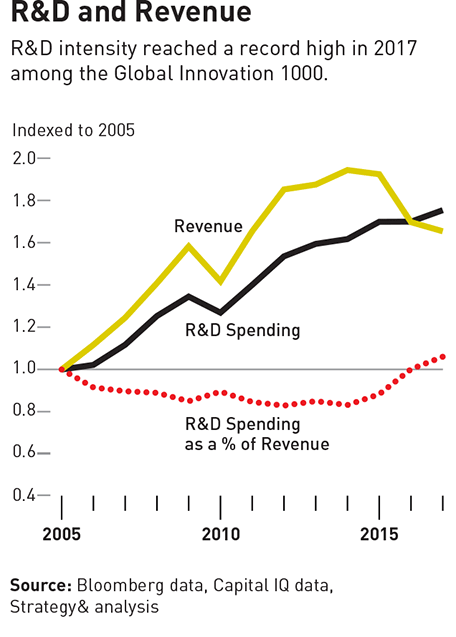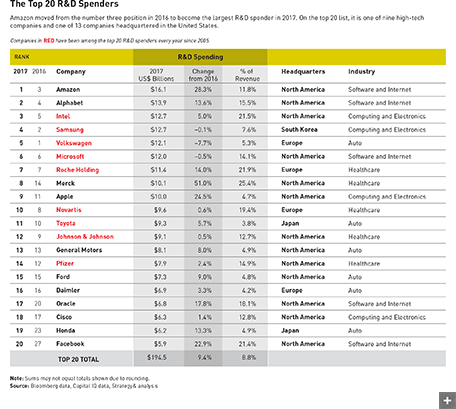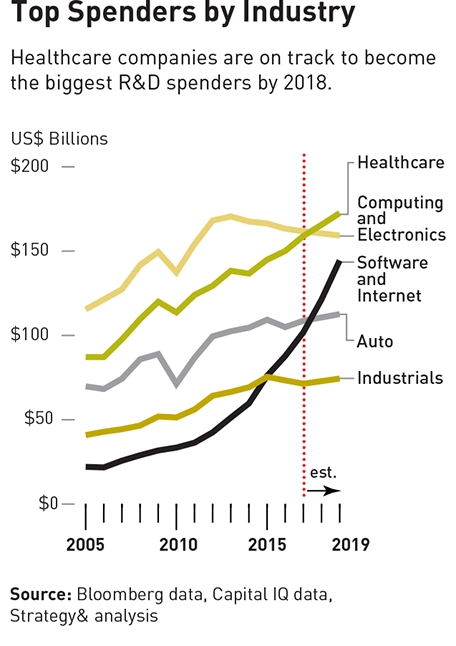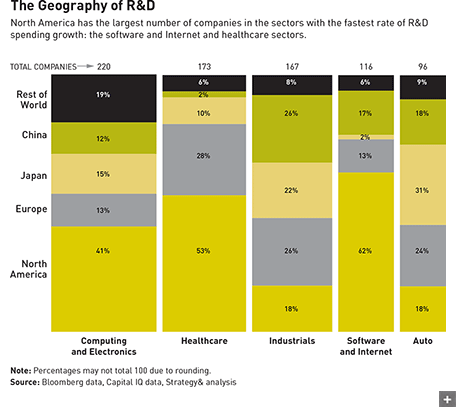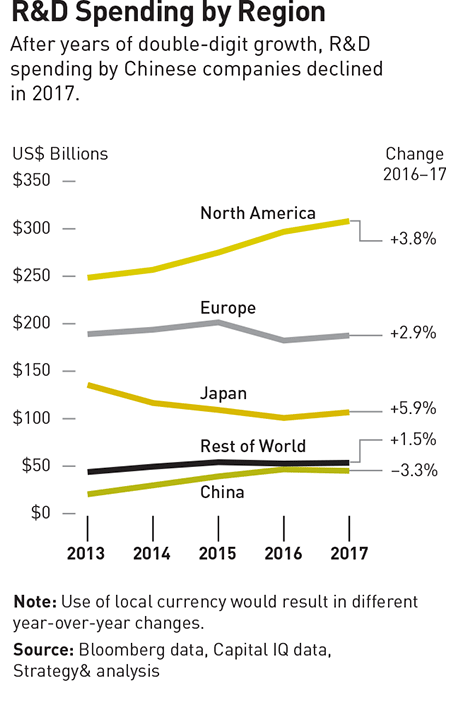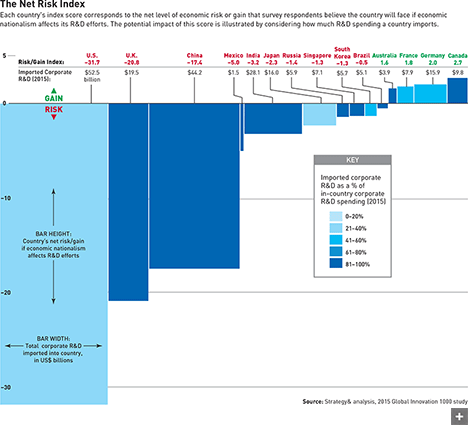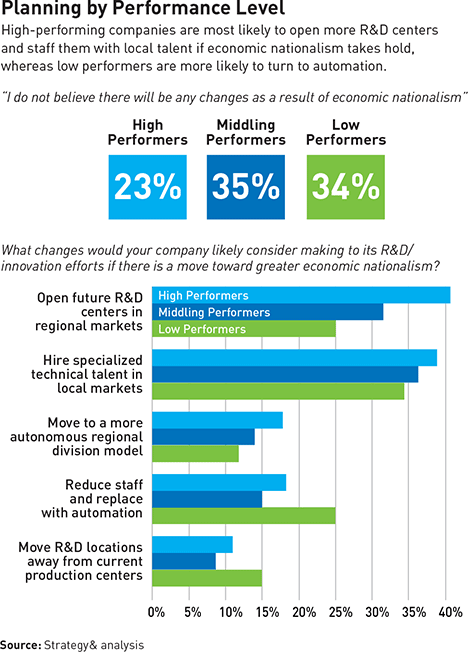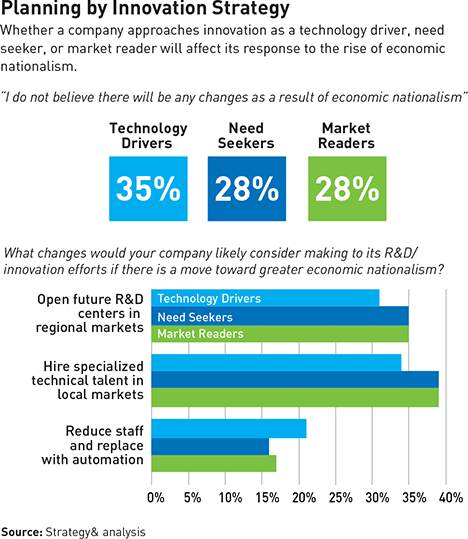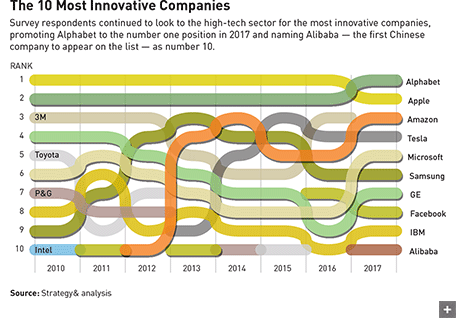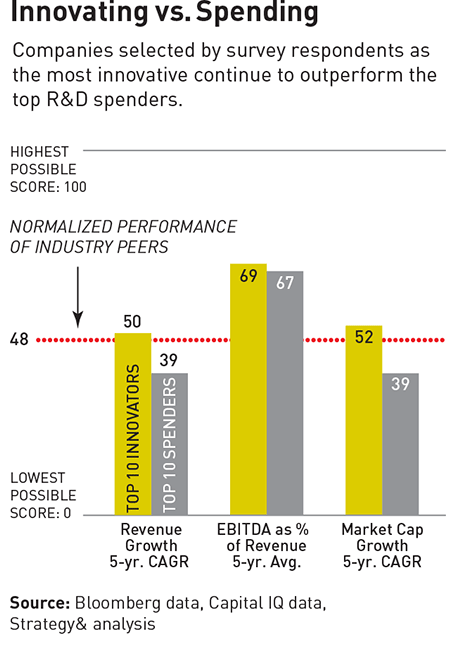Will Stronger Borders Weaken Innovation?
The flow of talent, investment, and ideas that has boosted companies’ global R&D efforts may soon be impeded by the rise of economic nationalism.

The political rhetoric of economic nationalism has grown heated in recent years. The clarion call often sounds for more restrictive trade or immigration policies that supporters believe will promote growth and employment at home. Studies have shown that a number of countries have embraced this mind-set to varying degrees, adopting policies that favor domestic industry and companies.
According to Global Trade Alert, the U.S., India, Russia, and Argentina implemented the most protectionist measures from November 2008 to June 2017. The Information Technology and Innovation Foundation reported in early 2017 on “mercantilist innovation policies” from the previous year, citing local data storage and technology transfer measures in China, Russia, Indonesia, and Vietnam, among others. China, though it relaxed some of its restrictions in 2016 after the data was collected, was ranked second out of 62 nations (behind the Philippines) in the OECD’s 2017 FDI regulatory restrictiveness index, which measures various foreign investment constraints. Then there are the headline-grabbing events that have both been fed by and contributed to the rise of economic nationalism: the U.K.’s decision in June 2016 to leave the European Union, the election of U.S. president Donald Trump last November on an “America First” platform, and the rise in uncertainty surrounding the future of various multilateral trade agreements.
Economic nationalism is motivated by a range of intentions, many of which continue to be debated. But it has an unanticipated consequence that has received less attention to date: As many politicians and policymakers in the world’s major economic powers look inward, the realm of innovation has been thrown into uncertainty. The global innovation model long embraced by leading multinationals, one based on the free flow of information, money, and talent across borders, is at risk. The policies inspired by economic nationalism may prove self-defeating, in part by disrupting R&D activities for the new products and services that will generate the jobs, growth, and wealth of the future. The danger of this new reality is exacerbated by the overall global trend of declining public-sector R&D spending growth.
Two years ago, in the 2015 Global Innovation 1000 study, our annual analysis of corporate R&D spending among the 1,000 largest publicly traded companies in the world, we mapped the development of the global innovation model. We found that more and more companies look for talent outside their headquarters country and set up R&D centers close to their target markets. They have grown skilled at managing these distributed elements, and are connecting them to a strong central R&D organization while maintaining fluidity throughout the network. Our study revealed that 94 percent of the largest R&D spenders follow such a global innovation model. The study also found that companies that deployed 60 percent or more of their R&D spending outside their headquarters country earned a premium of 30 percent on operating margin and return on assets, and 20 percent on growth in operating income over their more domestically focused competitors.
Going forward, multinational companies are uncertain whether the current political rhetoric will turn into policies with the potential to disrupt their global R&D networks. They are carefully watching the situation unfold, as they plan their business and innovation strategies. Although the goals of corporate innovation would likely not change if economic nationalism continues to proliferate, the global innovation model would need to evolve. At many companies, what is now a nimble, interdependent network may become a group of autonomous hubs. Unfortunately, in this scenario, companies are likely to lose efficiency, create redundancies, and take on higher costs.
“Even before [the events of 2016], the world has seen a declining rate of growth in R&D expenditure at both government and business levels,” says Soumitra Dutta, dean of the SC Johnson College of Business at Cornell University and coauthor of the annual Global Innovation Index (GII). “With the increased focus on nationalism and some protectionist tendencies, there’s a real fear that this downward trend might continue and that the gains from the globalization of R&D, which we all have benefited from, might not be as strong or might in fact become weaker going forward.” (The GII measures innovation performance in 127 economies, rather than the 1,000 top corporate spenders featured in our study.)
In fact, although corporate R&D spending among the Global Innovation 1000 continued to increase steadily in 2017 (see “Profiling the Global Innovation 1000” in the gray box below), our study shows that many companies are already feeling the effects of economic nationalism. A majority said a continued trend toward economic nationalism would have a significant or moderate effect on their R&D operations. Further, if more nationalistic policies are adopted, many said they will make changes to their R&D operations within the next two years, and three-quarters said they will act in the next five years.
Profiling the Global Innovation 1000
The companies in the Global Innovation 1000 increased their R&D spending by 3.2 percent in 2017, pushing it to an all-time high of US$702 billion. This marked a resumption of meaningful growth in innovation spending following flat results in 2016, and a reversion toward the mean compound annual growth rate of 4.8 percent of the last dozen years. Global private-sector R&D spending is now 2.7 times as high as it was in 1999, the first year for which we assembled data.
The rise in R&D spending came despite a 2.5 percent decline in revenue for the Global Innovation 1000 companies. This slump can be attributed largely to a 14.5 percent decrease in revenue in the chemicals and energy industry, which experienced a second year of depressed oil prices. The combination of overall R&D spending growth among the Global Innovation 1000 and lower revenues resulted in a record-high rate of R&D intensity (R&D spending as a percentage of revenues) of 4.5 percent (see “R&D and Revenue”).
For the first time in the study’s 13-year history, a software and Internet company — Amazon — led the top 20 R&D spenders, with outlays of $16.1 billion, followed by Alphabet (see “The Top 20 R&D Spenders”). In fact, all the software and Internet companies in the top 20 either stayed at their position or rose on the spending list in 2017, and for the first time, numbers one through four of the top 20 spenders list were high-tech companies. Honda and Facebook joined the ranks of the top 20 spenders in 2017 in the 19th and 20th places, respectively, replacing two pharmaceutical firms, AstraZeneca and Bristol-Myers Squibb.
As a group, the companies of the top 20 spent $194.5 billion on R&D in 2017; this figure represented 28 percent of the total spending of all the companies in the Global Innovation 1000. Thirteen of the top 20 spenders in 2017 were headquartered in the United States, reflecting U.S. dominance in the high-tech and healthcare industries, which tend toward high R&D intensity.
The top four industries by R&D spending — computing and electronics, healthcare, auto, and software and Internet — together accounted for more than 75 percent of all R&D spending by the Global Innovation 1000 companies. But looking ahead, the top four are in line for a shakeup. Healthcare companies increased R&D outlays by 5.9 percent in 2017, and are on track to supplant computing and electronics as the top R&D industry spender in 2018 (see “Top Spenders by Industry”). Meanwhile, growth in R&D spending for software and Internet companies, at 16.1 percent, was once again the fastest — by far — of all industries. Given their current trajectory, software and Internet companies will take the number three industry position in 2018, surpassing auto companies. The software and Internet and healthcare industries also added the largest number of companies to the Global Innovation 1000 in 2017: 13 new arrivals from the software and Internet sector, and nine from the healthcare sector.
On the other side, the industrials, computing and electronics, and chemicals and energy sectors saw the largest number of companies exiting the Global Innovation 1000. Companies in those three sectors, as well as consumer companies, decreased their R&D spending in 2017. Here we can contrast innovation spending on the hardware side of the digital world with that of spending on software. Although recording just a small dip this year, R&D spending by computing and electronics companies has dropped by 5.2 percent since 2013.
Among regions, North America has the largest number of companies in the healthcare, computing and electronics, and software and Internet industries in the Global Innovation 1000. Europe and China have the largest numbers of industrials companies, and Japan and Europe have the largest numbers of auto companies (see “The Geography of R&D”).
R&D spending at Japanese companies rose 5.9 percent in 2017 — the first increase for these companies in five years. Companies in the “rest of world” group upped R&D spending by 1.5 percent in 2017 (see “R&D Spending by Region”). Meanwhile, R&D spending rose at companies headquartered in North America by 3.8 percent in 2017, although that was less than half the 8 percent rate of growth in 2016. At European companies, spending rose 2.9 percent, partially offsetting a 9 percent decrease in 2016.
Finally, in China, R&D spending decelerated sharply. After growing consistently at double-digit rates since we began studying the Global Innovation 1000 in 2005, R&D spending at Chinese companies declined for the first time, by 3.3 percent. This decrease reflects the 11.4 percent drop in R&D spending in China’s industrials sector — still the country's highest-spending R&D industry — which has been affected by China’s general economic slowdown, and increasing financial constraints.
“Restrictions on visas, restrictions on talent movement, how easy it is to share technology and knowledge — none of these were issues we were talking about before our 2016 strategy review, and now they’re on our radar screen,” says Robert Pagano, chief executive officer of Watts Water Technologies, a U.S.-based global provider of products and solutions for the plumbing, heating, and water quality industry. Watts Water Technologies conducts R&D in North America, Europe, and Asia. As companies plan for their future R&D activities, says Pagano, “they will need to look at various scenarios based on the current and potential environment. The key is that you have to be flexible now, and careful not to commit [over the] long term to potential political hot spots. Uncertainty breeds uncertainty.”
Facing the Unknown
Major companies have been conducting some R&D outside their headquarters countries for decades. IBM founded its first overseas research center in 1956 in Switzerland, and Japanese auto companies began opening design centers in the U.S. in the 1960s. Beginning in the late 20th century, however, the movement toward global corporate R&D accelerated, both as business itself became increasingly globalized and as Web-based communications came of age. The main drivers for innovators were the ability to tap into wider talent pools and the opportunity to locate R&D facilities closer to growing markets and production facilities.
But economic nationalism is forcing companies headquartered around the globe to question the sustainability of their integrated global networks. Overall, 52 percent of respondents said that a general move toward economic nationalism will have a moderate or significant impact on their companies’ R&D efforts. Japanese respondents, relative to those in other regions, think the impact would be highest, with 58 percent envisioning moderate to severe effects. They are followed by respondents in Europe and the countries in our “rest of world” category, at 52 percent, and in North America, at 48 percent.
52 percent of respondents said that economic nationalism will have a moderate or significant impact on their companies’ R&D efforts.
Although nearly two-thirds of companies surveyed said they have not experienced pressure to change their approach to innovation in their headquarters country, 30 percent of respondents said that they’ve already felt pressure to change either where or how they conduct innovation work. In addition, 23 percent said they experienced such pressure in another country (outside their headquarters country). And nearly a third of companies surveyed reported that they have already felt the effects of economic nationalism on their R&D talent acquisition or retention because of visa or work restrictions — causing them to either lose employees, see less talent available, or hire more local talent.
An executive at one Europe-based multinational that conducts innovation over a large network in Europe, North America, and Asia explains that “our concern is more about what politicians are saying, rather than [about] what they’ve done at this point. A long-term worry is that if countries…in the future started limiting their people’s ability to work abroad — or if the U.S. encouraged reshoring of production or R&D, and others followed — we could come into a very fixed and inflexible world in terms of access to talent, and we have similar worries about how knowledge sharing and knowledge transfer could be affected.”
Uncertainty about economic nationalism may already be affecting companies’ strategic planning. One of the key characteristics of the most successful innovators, which we have studied in past years, is the degree of alignment companies achieve between their innovation strategies, which tend to be long term, and their business strategies, which tend to be short term. Our analyses have shown that when these strategies are closely aligned, companies consistently and significantly outperform their rivals on key financial metrics.
From 2014 through 2016, the percentage of survey respondents reporting that their company’s innovation strategies and business strategies were highly aligned rose steadily, from 27.7 to 31.8 percent. But in 2017, the percentage dropped to 25.8 percent — a 19 percent decline in a single year. We believe uncertainty about global economic and trade policy is the likely culprit. No other major changes in the business or economic landscapes explain this rapid decline.
Mapping Vulnerability
We asked our survey respondents which countries’ economies have the most to lose if economic nationalism affects R&D, and which will gain. In “The Net Risk Index,” we show respondents’ predictions about how countries will fare (we assigned each country a net risk index score based on the net calculation of respondents’ perceived economic risk and gain for each country) compared with countries’ structural risk. The latter is represented by the amount of corporate R&D conducted in each country by companies that are headquartered in other countries; we think of this as the amount of R&D in any country that is, in effect, “imported.” According to our survey respondents, the U.S. is the country where R&D operations are, by far, most vulnerable to rising economic nationalism. It is followed by the U.K., China, Mexico, and India.
As noted earlier, the global innovation model is powered by the relative free flow of information, money, and talent. The U.S. has the largest dollar volume of “imported” corporate R&D spending, according to our 2015 report on global innovation flows. China is the second-largest importer of R&D spending, but China’s imports make up a much larger percentage of total in-country corporate R&D spending (81 percent, versus 36 percent in the U.S.), making the country’s innovation efforts far more dependent on companies based overseas.
The United States. The U.S. is particularly vulnerable to disruptions in flows of talent. “Hiring talent is the most important thing we do in our organization,” says the chief technology officer of a U.S.-based electronics components manufacturer. “There’s a cost associated with hiring talent; it’s not easy, and it takes time.” Although the company’s talent acquisition efforts have not been affected so far, the executive notes that “any overly restrictive policy to granting student or working visas to qualified foreign talent — and ultimately accessibility to green cards — will have adverse effects on global corporations’ hiring strategies and should be a concern for U.S. policy leadership.”
Immigrants in the U.S. make up only 16.9 percent of the overall workforce, but they hold an outsized share of jobs in the high-tech, science, and engineering sectors. They account for 32 percent of workers in computer- and mathematics-related positions and 24 percent in other sciences and engineering, according to the Migration Policy Institute.
Among graduate students in the U.S., the proportion of international students in engineering and computer science programs (the prime recruiting pool for many corporate R&D positions) is far higher than the proportion of immigrants in the overall population. Eighty-one percent of graduate students in U.S. electrical engineering programs are from other countries, as are 79 percent of those in computer science programs; 75 percent in industrial engineering; and 62 percent in mechanical engineering, according to the National Foundation for American Policy (pdf).
“The U.S. doesn’t churn out enough engineers by far — either in quality or in quantity, and has been making up the difference with imports of foreign talent, usually starting with people coming out of U.S. universities,” says the electronics components executive quoted above.
The United States’ turn toward economic nationalism has already affected applications to U.S. institutions from foreign students. Although comprehensive data on national applications and enrollments won’t be available until early 2018, a survey (pdf) conducted in March 2017 by the American Association of Collegiate Registrars and Admissions Officers, in partnership with several other education organizations, found that about 39 percent of institutions had seen significant declines in international applications. Anecdotal evidence from specific graduate schools shows declines in international applications in the range of 10 to 30 percent.
At San Jose State University, for example — where the Charles W. Davidson College of Engineering is a major supplier of R&D talent for Silicon Valley companies — applications from overseas graduate students were down 15 percent for the 2017–18 school year, although the school was still able to maintain its enrollment levels of international students. Potential students from overseas and their families are concerned about safety in the U.S., about possible visa difficulties, and about the ability to pursue job opportunities in the U.S. after graduation, according to school officials.
“We’re in the same wait-and-see mode as corporations,” says Sheryl Ehrman, dean of the engineering school at San Jose State. “Any change in visa or work training requirements would be a huge concern for us, and likewise [for] our industry partners who hire our students.” Adds Ehrman, “I grew up in the Valley, and I know the contribution that immigrants have made at all levels to the booming economy here. If we don’t have that influx of people, and a welcoming environment where people can contribute, we’re going to lose our economic edge.”
Economic nationalism may be an even bigger issue for smaller schools not located near major cities. At Texas Tech University, in Lubbock, applications from international students are down 20 percent for 2017, and admissions of international students are down 7 percent. Brandon Weeks, associate dean of research and graduate programs, says, “There’s a lot of angst among students about what’s going to happen in the future, and I think mid-tier universities like Texas Tech are probably going to feel the pain first — and I think we’re starting to feel it.”
Meanwhile, other countries have responded to such developments in the U.S. by courting international students for their own universities, publicizing their more welcoming and transparent immigration policies. Both Canada and Australia have revamped their policies for international students, offering streamlined application processes, easier visa and work–study rules, and more certain paths to citizenship for students who want to remain after graduation. China has made major investments to fund its higher education system in order to develop, attract, and retain its own R&D talent base since the 1990s.
The United Kingdom. The second most vulnerable country, according to our survey, is the United Kingdom. With the Brexit negotiations under way, it’s still not clear how much the pending withdrawal from the European Union will inhibit the recruiting ability of British companies and universities. In the run-up to the Brexit vote, Britain’s Institution of Engineering and Technology, one of the world’s largest engineering organizations, warned that the country’s existing shortage of skilled workers could hit a crisis point if companies face barriers to recruiting engineers from other E.U. countries. In addition, British university officials have warned that applications from E.U. students will be down in 2017, after having risen steadily in previous years. In late 2016, Cambridge University reported a drop of 17 percent in E.U. undergraduate applications for 2017.
Weaker R&D programs in the U.K. could also have a ripple effect across the region. Although the end result of Brexit in the U.K. is unclear, the European executive quoted above expressed concern that if the U.K. becomes more isolated, “the economic power and skill of the U.K. might deteriorate, and Europe as a whole — not necessarily the European Union — will become weaker compared with Asia and the Americas.” It’s worth noting that Europe’s overall position in global innovation has already deteriorated over the past decade. Our 2015 analysis of global innovation flows revealed that between 2007 and 2015, R&D spending in Europe had fallen from first place among regions to third, after Asia and North America.
China. The third most frequently cited country at risk is China. This is understandable: Total corporate R&D spending in China grew 120 percent from 2007 to 2015 (to US$55 billion) , but more than 80 percent of that R&D spending in 2015 ($44 billion) was performed by companies headquartered in other countries, with the largest single source being the United States. In addition, although domestic corporate R&D spending in China had been growing at double-digit rates for many years, that trend reversed in 2017. R&D spending by China-based companies declined by 3.3 percent — the first decrease since we created the Global Innovation 1000 in 2005. Together, these trends make the country particularly vulnerable to disruptions of R&D investment that may come from abroad.
However, 25 percent of our respondents believe that China’s economy would benefit from the impact of economic nationalism on global R&D (compared with 43 percent who thought it was at risk). China still has many attractions as an R&D location, including its proximity to a high-growth market and key manufacturing sites, as well as low development costs. If immigration and trade policies in other regions, including the U.S., were to become less welcoming for R&D operations, China could be a beneficiary of increased innovation flows from companies based in Australia, Canada, or Europe, or even those in the United States and the United Kingdom.
Other countries that are at risk or may gain. Our survey respondents believe several other countries are also at risk from economic nationalism, though to a smaller degree than the U.S., U.K., and China. R&D spending in Mexico, for example, could be affected by U.S. policy actions, given the country’s close trade relations with the United States. India’s R&D spending is dominated by investment from multinationals based in other countries, making it vulnerable. Total R&D spending in India grew 115 percent from 2007 to 2015, to $28 billion; that growth was driven almost entirely by companies from other countries as India became the leading global destination for offshored software R&D. However, it is worth noting that India was ranked number four in both potential risk and potential gain by our respondents. It’s possible that countries may decide to double down on their software R&D in India, setting up larger and more autonomous innovation hubs in the country.
Our survey additionally indicates that R&D in several countries would be likely to benefit modestly if economic nationalism and protectionism rise. At the top of this list is Canada, which, as previously noted, is aiming to attract international innovation talent to its university system as the U.S. tightens visa and immigration programs. And Canada is already an attractive North American alternative for multinationals. Microsoft, for example, opened an R&D center in 2016 in downtown Vancouver, just across the U.S. border, with 750 R&D positions and an estimated economic impact of US$180 million per year. Second most likely to benefit, according to our respondents, is Germany, which has pointedly reiterated its pro-globalization policy stance. Such openness is important to the German economy; exports make up close to 47 percent of German's GDP. Germany is followed by France, where newly elected president Emmanuel Macron ran on a platform stressing the importance of innovation for the French economy. Both countries are being eyed by companies that may need to relocate U.K.-based hubs; several major banks have already announced plans to transfer jobs from London to Frankfurt.
Preparing to Respond
The executives we interviewed underscored the fact that they would act in the best interests of their company if pressures from economic nationalism were to constrain talent availability in their headquarters countries. Arthur Orduña, executive vice president and chief innovation officer of Avis Budget Group, a global provider of mobility solutions whose brands include Avis, Budget, and Zipcar, says: “We have not yet seen any direct effect on R&D talent acquisition from a software and engineering perspective. If policy changes led to talent acquisition challenges, we would take the appropriate steps to meet our business objectives.”
Our survey respondents said if economic nationalism continues to rise, they will make a range of changes to keep their companies’ R&D operations vibrant, and the potential actions they cited most frequently help us envision how global R&D models may evolve as a result. The key finding is that in an environment where talent mobility is challenged, companies would be most likely to hire specialized talent in local regional markets rather than in their headquarters country (reported by 37 percent of respondents), and would open future R&D locations in regional markets (33 percent).
If talent mobility is challenged, companies are likely to hire specialized talent in local markets rather than in their headquarters country.
Other respondents (18 percent) cited reducing staff and increasing automation as a likely response if economic nationalism takes hold. Of course, automation is a solution to a different problem. It can lower costs that build up as a result of the redundancies and inefficiencies that come with having to set up a more autonomous innovation model. Automation doesn’t, however, address the problem of not being able to relocate (or hire) your top talent in the most appropriate, highest-value R&D locations. The evolving model would also depend even more on digital collaboration tools, and people would be less able to move freely throughout the network. Of our respondents, 59 percent said that economic nationalism would lead them to increase their use of such tools.
Perhaps reflecting the uncertainty about potential policy changes, our respondents reported mixed opinions about the effects on intellectual property policies: 20 percent said they would be more willing to share intellectual property across borders, whereas 16 percent said they would be more likely to limit such sharing. The political uncertainty is creating planning uncertainty.
When we dig deeper and examine responses on the basis of companies’ performance level and their innovation strategy, differences emerge in individual needs and abilities. For example, the middling and lower-performing companies among our survey respondents were the most doubtful that economic nationalism would necessitate changes in their R&D operations — 35 and 34 percent of respondents in these two groups, respectively, reported that they did not believe there would be any changes as a result of economic nationalism. This compares with 23 percent of respondents from high-performing companies who held this belief. (Company performance level was self-reported by respondents, who were asked if their organization’s revenue growth was faster than, slower than, or the same as that of their key competitors.)
The high performers, then, are more likely to anticipate changes. And they are also more likely to take action. Forty-one percent said they would open future R&D centers in regional markets, compared with only 25 percent of low-performing companies. And 39 percent of high performers reported that they would hire more specialized technical talent in local regional markets, compared with 34 percent of low-performing companies. Interestingly, low-performing companies were most likely to take an action that could be harmful to their overall R&D operations: 15 percent said they would move R&D locations away from current manufacturing or production centers, compared with 11 percent of high performers (see “Planning by Performance Level”).
For the past 10 years, the Global Innovation 1000 study has tracked (along with other factors) the distinct innovation strategies companies use to create their products and take them to market. Nearly every company, we have found, follows one of three fundamental innovation strategies: Need Seekers focus on engaging customers directly to generate new insights and develop products and services based on superior end-user understanding, aiming to fill unarticulated needs. Market Readers monitor competitors and customers closely to create value by capitalizing on market trends as fast followers to meet customers’ articulated needs. Technology Drivers use their internal technological capabilities to develop new products and services and seek to push these technologies out into the market in search of desirable applications.
For need seekers and technology drivers, innovation spending is more central to the overall business model and strategy than it is for other companies. Their R&D spending as a percentage of revenue is about twice as high as that of market readers. It’s therefore natural that need seekers and technology drivers see more risks to their operations from economic nationalism (when asked how much their R&D would be affected by a move toward economic nationalism, 56 percent and 54 percent, respectively, say that they perceive moderate to significant impact) than market readers do (47 percent).
Both need seekers and market readers are slightly more likely to hire specialized talent in local regional markets or to open future R&D centers in regional markets than technology drivers if economic nationalism proliferates. Although technology drivers are most likely to think no changes will be needed, they tend to be the companies with the largest engineering centers, and are the most likely to turn to automation if economic nationalism affects their operations (see “Planning by Innovation Strategy”).
The Law of Unintended Consequences
Short of a prolonged global trade war on the scale of the 1930s, when countries vied with one another to erect higher trade barriers as the world economy contracted during the Great Depression, it seems certain that the prevailing global innovation model developed over the last several decades will not vanish. Luca Savi, executive vice president and chief operating officer of ITT Corporation, a globally diversified high-technology engineering and manufacturing company based in White Plains, N.Y., told us that he sees few concerns about R&D operations or talent acquisition from rising protectionism in the short term to medium term, and remains confident that “common sense will prevail in the long term.”
But if economic nationalism does take hold, the global innovation model could be forced to change to reflect the new normal. We believe that the result would be the evolution of today’s integrated and interdependent network into one with more self-sufficient, fully functioning R&D nodes. These nodes will be more autonomous in terms of both their decision rights and their capabilities. Companies will need to look for ways to manage the higher costs they will incur with this model, for example, as a result of redundancies that are created when top talent cannot move easily throughout the network but instead needs to be hired in each location.
We’ve seen a similar type of autonomous model before. Two of the largest aerospace programs in history — Lockheed Martin’s F-35 Joint Strike Fighter and Boeing’s Dreamliner — were developed in long-term agreements with networks of partner countries and companies, in globally dispersed models for sharing R&D and production costs. The benefits included wider markets for the aircraft; reduced up-front investment and risk; and closer relationships with foreign governments, suppliers, and customers. But these arrangements also entailed complex program management challenges and significant transfers of technology. Other industries and projects that are national priorities — such as automotive, clean technologies, semiconductors, and software — might find themselves facing similar opportunities and politically driven challenges.
Meanwhile, the wait-and-see stance that many companies are adopting is appropriate, as it remains difficult to judge the degree to which the rhetoric of economic nationalism and protectionism will translate into policy actions. As Mike Sutter, president and CEO of Chromalox, which specializes in advanced thermal technologies and is a U.S. subsidiary of the U.K.-based firm Spirax-Sarco, noted: “As we do our 2018 budgeting, we’re adding a placeholder for what we’re generally terming protectionism. It is not something we have been concerned about in the past, and we don’t plan to spend a whole lot of time on it, because there’s just such a darned lack of clarity. It may turn out to be something, it may turn out to be nothing.”
But business leaders need to develop contingency plans now. For example, they must consider the potential realignment of business and innovation strategies and how a more autonomous and redundant R&D network would operate. They need to consider how they will staff and resource their R&D centers: Moving them away from their manufacturing and production centers would be shortsighted. Instead, they should prepare these centers to be more self-sufficient. They must also consider whether they have access to the digital collaboration tools they will need to maintain communications and efficiency and to manage rising costs. Taking a step back, companies also must recognize that economic nationalism can pose a strategic risk — of which the risk to their ability to be effective innovators is a critical component. Companies need to make sure they are bringing the right people to the table alongside their R&D leaders, to think through these issues and their potential downside.
Even though companies are hedging their bets, the executives we interviewed remain uniformly hopeful that the trend toward greater economic nationalism will not continue. “My hope is that economic nationalism doesn’t increase,” says Avis Budget Group’s Orduña. “My personal experience is that the technology, engineering, and science communities are inherently universal. There’s competitiveness, of course, but collaboration and openness are cornerstones of each of these.”
As policies based on economic nationalism continue to be debated, the potential impact on companies’ R&D strategy and operations cannot be left out of the discussion. The result of such policies could be innovation programs that grow ever more costly and cumbersome. That’s an unintended consequence that should be approached with caution. Innovation fuels growth, it improves lives, it creates jobs — and these are goals that connect us all.
The 10 Most Innovative Companies
Alphabet (formerly Google) was selected as the world’s most innovative company by respondents to our 2017 Global Innovation 1000 survey.
The company had been steadily closing the gap with Apple, which had held the number one spot since we first asked respondents to identify the most innovative company, in 2010. Alphabet’s top ranking comes just two years after Google announced its holding company structure, separating its more mature businesses from new ventures in such fields as autonomous vehicles and life sciences.
Apple, at number two, has its own distinction: It is by far the most efficient innovator among major players in the computing and electronics and software and Internet sectors. The company spent US$10 billion on R&D in 2017 — a mere 4.7 percent of its revenues. Apple spends up to 60 percent less on R&D as a percentage of revenue than do other top computing and electronics companies.
Amazon moved from fifth place in 2016 to third in 2017. This is perhaps not surprising given the company’s reach and ambitions, which expanded to include retail grocery with its June 2017 acquisition of Whole Foods. Tesla, which made headlines with the launch of its mass-market electric sedan and lithium–ion battery program, maintained its number four position. It remains the only auto company on the list. For the first time, a Chinese company — e-commerce giant Alibaba — was ranked among the most innovative, coming in at number 10. It is the second online retailer (after Amazon) to be selected by respondents. Making a departure from the list this year was 3M, which had been a member of the top 10 since 2010.
Eight of the 10 most innovative companies this year are headquartered in the United States. It is also noteworthy that half of the 10 most innovative companies were founded within just the last 25 years — Amazon in 1994, Alphabet (as Google) in 1998, Alibaba in 1999, Tesla in 2003, and Facebook in 2004. But General Electric, founded more than a century ago by innovation wizard Thomas Edison, is holding strong at number seven (up from number nine in 2016).
As in all previous years, the 10 most innovative companies outperformed the 10 biggest R&D spenders on a variety of financial metrics (see “Innovating vs. Spending”). (Six of the 10 companies on the most innovative list — Alphabet, Amazon, Apple, Facebook, Microsoft, and Samsung — also appear on the top 20 R&D spenders list.) The 10 most innovative once again beat the top 10 R&D spenders by double digits on both average five-year revenue growth and market cap growth, and also posted slightly higher five-year EBITDA as a percentage of revenue.
Methodology
As it has in each of the past 12 editions of the Global Innovation 1000, this year Strategy&, PwC’s strategy consulting business, identified the 1,000 public companies around the world that spent the most on R&D during the last fiscal year, as of June 30, 2017. To be included, companies had to make their R&D spending numbers public. Subsidiaries that were more than 50 percent owned by a single corporate parent during the period were excluded if their financial results were included in the parent company’s financials. The Global Innovation 1000 companies collectively account for 40 percent of the world’s R&D spending, from all sources, including corporate and government sources.
In 2013, Strategy& made some adjustments to the data collection process in order to gain a more accurate and complete picture of innovation spending. In prior years, both capitalized and amortized R&D expenditures were excluded. Starting in 2013, we included the most recent fiscal year’s amortization of capitalized R&D expenditures for relevant companies in calculating the total R&D investment, while continuing to exclude any non-amortized capitalized costs. We have now applied this methodology to all previous years’ data; as a result, historical data referenced in the studies from 2014 onward will not always align with previously published figures for the 2005 through 2012 studies.
For each of the top 1,000 companies, we obtained from Bloomberg and Capital IQ the key financial metrics for 2012 through 2017, including sales, gross profit, operating profit, net profit, historical R&D expenditures, and market capitalization. All sales and R&D expenditure figures in foreign currencies were converted into U.S. dollars according to an average of the exchange rate over the relevant period; for data on share prices, we used the exchange rate on the last day of the period.
All companies were coded into one of nine industry sectors (or “other”) according to Capital IQ’s industry designations, and into one of five regional designations, as determined by their reported headquarters locations. To enable meaningful comparisons across industries, the R&D spending levels and financial performance metrics of each company were indexed against the average values in its own industry.
Finally, to understand the ways in which global R&D is and will be conducted at companies across multiple industries, Strategy& conducted an online survey of 562 innovation leaders around the world. The companies participating represented more than US$100 billion in R&D spending, or 14.4 percent of this year’s total Global Innovation 1000 R&D spending; all nine of the industry sectors; and all five geographic regions.
Reprint No. 17407
Author profiles:
- Barry Jaruzelski is a thought leader with Strategy&, PwC’s strategy consulting business, where he advises senior high-tech and industrials executives on corporate and innovation strategy. In 2005, he created the Global Innovation 1000 study, and in 2013 was named one of the Top 25 Consultants by Consulting magazine. He is a principal with PwC US and is based in Florham Park, N.J.
- Volker Staack is a leading practitioner in Strategy&’s innovation practice, working with automotive, industrials, and technology companies, to help them build competitive innovation capabilities from strategy to execution. He is a principal with PwC US and is based in Miami.
- Robert Chwalik is an advisor to executives in the automotive, industrials, and oil and gas industries for Strategy&, helping them improve both top-line growth and bottom-line performance in such key operational and strategic areas as global engineering and product innovation. He is a principal with PwC US and is based in New York.


